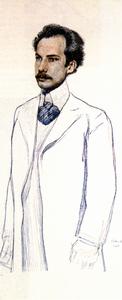 Bely, Andrei. Pseudonym of Boris Nikolaevich Bugaev, born on 26 October 1880 in Moscow. The duality which suffused much of Bely's work perhaps began in his childhood. His father, Nikolai Vasilevich Bugaev, a well-know mathematician at Moscow University, was autocratic and firmly committed to the natural sciences, while Bely's mother insisted--sometimes irrationally--on a dedication to the arts. The conflicts between his parents had an unfortunate effect on the psyche of their young son.
Bely, Andrei. Pseudonym of Boris Nikolaevich Bugaev, born on 26 October 1880 in Moscow. The duality which suffused much of Bely's work perhaps began in his childhood. His father, Nikolai Vasilevich Bugaev, a well-know mathematician at Moscow University, was autocratic and firmly committed to the natural sciences, while Bely's mother insisted--sometimes irrationally--on a dedication to the arts. The conflicts between his parents had an unfortunate effect on the psyche of their young son.At age 15, Bely became acquainted with the family of Mikhail Solovyov, the younger brother of the famous philosopher Vladimir Solovyov. In the Solovyov home, Bely was exposed to a wide range of cultured guests and discussions of art. Bely himself described meetings at the Solovyov home "sessions of the Florence Academy". In 1899, Bely graduated from the well-regarded private gymnasium of L.I Polivanov. He entered Moscow University and graduated in 1903 with a degree in natural sciences. In 1904 he enrolled in the university's historical-philological faculty, but soon gave up his studies and by 1906 he had decided to give himself fully to writing. His writing career began in 1902 with the publication of his "Second Symphony, the Dramatic", under the pseudonym of Andrei Bely, which was suggested by Mikhail Solovyov. Bely was to publish three more "symphonies", "The Northern, or First--Heroic" (1904), "The Return--Third" (1905) and "Goblet of Blilzzards--Fourth" (1908). These "symphonies" were an attempt at a synthesis of word and music, using a system of leitmotifs, a rhythmyzation of prose and an application of the structural laws of music to a literary composition. These works were also influenced by Vladimir Solovyov's concept of "all-in-oneness". A recurring image in these symphonies is that of Sophia—Holy Wisdom and the Eternal Feminine. Between 1901 and 1903 he fell in with a group of Moscow symbolists (including Briusov and Balmont) associated with the publisher "Scorpion". In the autumn of 1903 Bely was one of the organizers of the Argonauts, who preached the ideas of symbolism as religious creation and the equality of the "text of life" with the "text of art". It was during this period that he published the poetry volume "Gold in Azure" (1904). Shortly thereafter, however, Bely's philosophical orientation changed from Nietzsche and Solovyov to neo-Kantian. He viewed the revolutionary events of 1905 as anarchistic maximalism. During the same period, his poems began to take on social themes, Nekrasov rhythms and intonations, as shown in the volume "Ash" (1909), which Bely dedicated to Nekrasov. Bely had a very difficult relationship with Blok and an unrequited love relationship with Blok's wife, Lyubov, whom Bely identified with the Holy Sophia, reflected in the poetry collection "Urn" (1909). In 1910 and 1911, Bely published three volumes of critical and theoretical articles, "Symbolism" (1910), "Green Meadow" (1910), and "Arabeques" (1911). The novel "The Silver Dove" appeared in 1910. This latter work is the tale of a young poet who leaves the city to join a group of religious sectarians and ends up being murdered by them. About this time, he also began a relationship with Asya Turgeneva. Between 1910 and 1912 they traveled through Sicily, Tunis, Egypt, and Palestine. 1913 saw the publication of his most influential novel, "Petersburg". Set in the imperial metropolis in the revolutionary year 1905, "Petersburg" centers around a plot to deliver a bomb to a high government official. The geometric precision of the city clashes with the forces of chaos swirling around, and the swamp on which the city is built threatens to rise up again. Bely then fell under the sway of the anthroposophical teachings of Rudolph Steiner and by 1914 he was in Dornach, Switzerland, assisting in the construction of Steiner's Anthroposophical Temple. In 1914 and 1915 Bely was also working on the novel "Kotik Letaev", an autobiographical retelling of his childhood. In 1916, during World War I, leaving Asya Turgeneva in Switzerland, Bely returned to Russia and somehow avoided military service. His reaction to the Revolution of 1917 was that it presented a possible way of avoiding global catastrophe. He worked as a librarian and archivist while also lecturing on literature and anthroposophical ideas. He also was a reader of manuscripts for Proletkult. Of notable interest from this period are his essay "Revolution and Culture" (1917) and the poem "Christ Has Risen" (1918). In 1921, Bely returned to Europe, but had a falling out with both Steiner and Turgeneva. In 1922 he published "Recollections of Blok". Bely returned to Russia in 1923 where he married Klavdiya Vasilieva and worked on his trilogy of Moscow novels: "The Moscow Eccentric" (1926), "Moscow Under Seige" (1926) and "Masks" (1931). He also completed three volumes of memoirs: "At the Border of Two Centuries" (1930), "The Beginning of the Century" (1933) and "Between Two Revolutions" (1934). "The Baptized Chinaman", a continuation of the Kotik Letaev story, appeared in 1927. Bely also produced literary studies such as "Rhythm as Dialectic in The Bronze Horseman" and "The Mastery of Gogol" (1934). Bely died on 1 August 1934. In the autumn of 2000, Bely's apartment in Moscow at Arbat, 55, was opened as a public museum. |
Return to: ENCYLOPEDIA OF SOVIET WRITERS
Return to: SovLit.net
editor@sovlit.net
(c) 2012 SovLit.net. All rights reserved.